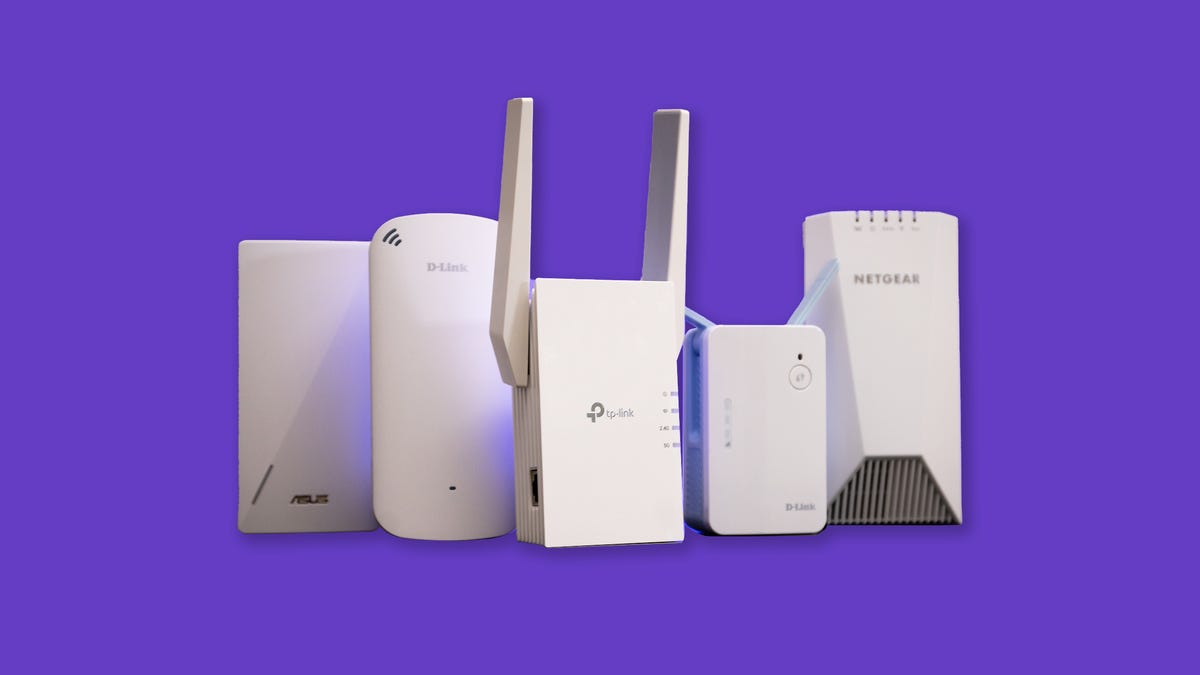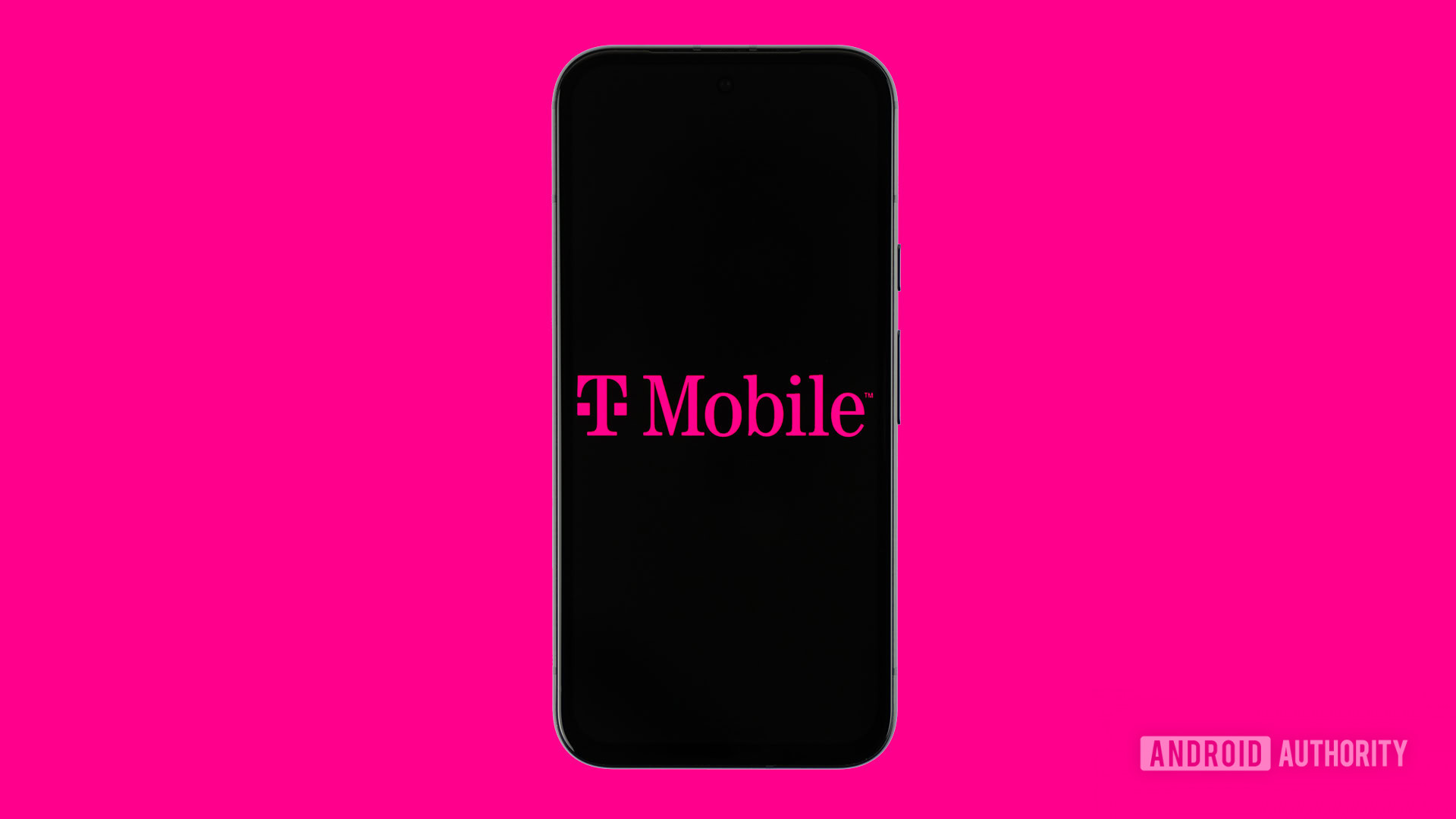Our picks
Why we chose these providers
Sort by
Linksys RE7310
A solid second choice for best Wi-Fi extender

D-Link DAP-X1870
Wait for a sale for this Wi-Fi extender

TP-Link RE505X
Solid Wi-Fi extender performance for the price
Wi-Fi routers can do a lot of things these days, but walls and floors still get the best of them. If you’re experiencing dead zones in your home, you have two options: upgrade to a mesh router or add a Wi-Fi extender to your existing router. For as little as $20, a Wi-Fi extender will boost your internet signal to a specific area without having to buy a whole new setup, and installation is as simple as plugging the extender into an electrical outlet and connecting it to your Wi-Fi router. If that sounds too good to be true, it kind of is.
’s testing has found that Wi-Fi extenders can be a great solution if you’re looking to improve the connection in a single room, but you’ll probably be disappointed if you’re hoping to boost the speeds to an entire floor or wing of your home. For that, you’re better off upgrading to a full-fledged mesh system.
What is the best Wi-Fi extender overall?
The best Wi-Fi extender for most people is the TP-Link RE605X. While it’s slightly more expensive than other models at $100, it delivered significant speed boosts in every room I tested, and it offers full support for Wi-Fi 6 speeds.
If you’re looking for something more affordable, there are plenty of options for under $50, although not all of them have Wi-Fi 6 support. I’ve spent the past few years regularly testing them out to find the best of the bunch. After countless tests, my data identified the range extenders that reigned supreme. Let’s get right to them.
Best Wi-Fi extenders for 2024
TP-Link RE605X
Best overall Wi-Fi extender
TP-Link makes some of the most popular picks in the range extender category, with a fairly wide variety of options to choose from at various price points. If you’re buying one in 2024, I think you should put the TP-Link RE605X right at the top of your list. At $100, it’s far from the most affordable extender on the market (keep reading for the value picks), but with a highly capable AX1800 design, full support for the latest Wi-Fi 6 speeds and features, adjustable antennas and a helpful, easy-to-use control app with strong reviews on both Android and iOS, it’s about as well-rounded as range extenders get.
The performance is particularly sharp too. In my tests at the Smart Home, an RE605X in the basement was able to extend the router’s signal from upstairs just fine, giving my upload and download speeds a significant boost in every room I tested. Throughout the entire 5,800-square-foot-home, among all the extenders I tested, the RE605X delivered the fastest average upload speeds to both Wi-Fi 5 and Wi-Fi 6 devices, the fastest average download speeds to Wi-Fi 6 devices and the second fastest average download speeds to Wi-Fi 5 devices.
By default, the extender puts out its own separate network when you first pair it with your router, and that network will use the same password as your original network, and the same SSID with “-EXT” added to the end. That’s better than extenders that put out an unsecured network by default — and if you use the app to delete that “-EXT” bit, it’ll automatically sync up with your original network and work invisibly to keep you better connected, which is ideal. All of that makes this extender an easy recommendation.
…Read more
Linksys RE7310
A solid second choice for best Wi-Fi extender
TP-Link took the top spot, but the Linksys RE7310 was very close behind it, and would be almost equally as good on most home networks. In the Smart Home, where we have a fiber internet plan with uploads and downloads of up to 150Mbps, the RE7310 returned average Wi-Fi 6 downloads throughout the entire multistory house of 132Mbps. That’s only 4Mbps behind that top pick from TP-Link. As for the uploads, Linksys finished with an average whole-home speed to my Wi-Fi 6 test device of 124Mbps. That’s only 2Mbps behind TP-Link.
The only thing keeping me from saying that the two finished in a virtual tie is that the RE7310 was slightly less impressive with earlier-gen Wi-Fi 5 devices, particularly with respect to upload speeds. Still, the performance was solid across the board, and strong enough for me to take video calls in the Smart Home’s basement dead zones, something I would have struggled with using just the single router I ran my tests on. It’s a bit bulky-looking, but the RE7310 is the best Linksys range extender I’ve tested yet, and it’s an especially great pick if you can catch it on sale.
…Read more
TP-Link RE220
The best budget Wi-Fi extender
The TP-Link RE220 was the least expensive range extender during my first run of at-home tests, but that didn’t stop it from outperforming everything else I tested at every turn. As Wi-Fi extenders go, it’s fast, it’s reliable, it works with just about every Wi-Fi router out there, and it’s easy to use. And, as of writing this, it costs even less than I paid for it initially — down to $16 on Amazon.
Plug it in and press the WPS button to pair it with your home network, and it’ll begin broadcasting its own networks on the 2.4GHz and 5GHz bands. Both offered steady Wi-Fi speeds throughout my home, including average download speeds on the 5GHz band of at least 75Mbps in every room access point I tested, along with strong upload speeds. The RE220 never once dropped my connection, and its speeds were consistent across multiple days of tests during both daytime and evening hours.
It’s a little long in the tooth at this point, and it won’t wow you with Wi-Fi 6 speeds, but the strong ease of use and the steady, dependable level of performance it offers mean it’s still an absolute steal. It’s not as fast as the top models I’ve tested in the years since, and I haven’t had a chance to retest it at the Smart Home just yet — but it’s still a great choice if you want to boost the signal from the Wi-Fi router to a back room that sits beyond the router’s reach, but you’d like to pay as little as possible to get the job done.
…Read more
D-Link DAP-X1870
Wait for a sale for this Wi-Fi extender
Another strong model from my tests, the D-Link DAP-X1870 is an excellent performer that does a great job of creating a single, unified network as soon as you pair it with your router. That keeps things easy, but at a retail price around $80, it feels a bit too expensive here in 2024.
I’d probably stick with the $16 TP-Link RE220 if I were just looking for the best value pick. I’ll keep an eye out for any other good sales and update this post as I spot them.
…Read more
TP-Link RE505X
Solid Wi-Fi extender performance for the price
Last year’s top pick, the RE505X is just a slightly less powerful version of the RE605X that costs a bit less. I wasn’t able to retest it at the Smart Home yet, but I’ll update this post when I get the chance. For now, I think performance-minded users will be glad they spent up for the better upload speeds of the RE605X or the Linksys RE7310, and value-minded users will likely be better served with the less expensive D-Link EaglePro AI and TP-Link RE220 range extenders.
That leaves the RE505X as a bit of a middle child at this point, but I’d pounce on it if the price dropped substantially below its current price of $50 at Best Buy, as it was an extremely capable and consistent performer in my earlier tests.
…Read more
What is a Wi-Fi range extender?
Also called a Wi-Fi signal booster, a range or Wi-Fi extender is a compact, plug-in device that is simple and hassle-free to implement. Wi-Fi extenders use built-in Wi-Fi radios and antennas to pair wirelessly with your router. No Ethernet cable is required. Plug in one near the edge of your router’s wireless range and pair it with the network, and it’ll start rebroadcasting the signal farther out for significantly faster internet speeds throughout your home.
Should I buy a Wi-Fi extender?
Wi-Fi extenders are great options when you have a single room that you want to give a speed boost. Wi-Fi extenders are generally less expensive than upgrading to a full-fledged mesh router with its own mesh Wi-Fi systems and range-extending satellite devices. Plus, they are generally a cinch to set up, they’ll work no matter what brand of router you’re using, and you can typically use the same SSID and password as your original router. That creates a single, seamless connection that will give you the best Wi-Fi range available with your current setup — all without you needing to think about it too much.
However, signal boosters can’t extend your Wi-Fi signal to an entire floor or side of the house like a mesh router can. An extender is also only as good as the router it’s connected to, which means you won’t see huge improvements if your router is failing, outdated or in the wrong spot.
I spent weeks testing these range extenders at the Smart Home.
How tests Wi-Fi extenders and signal boosters
In 2022, I was able to resume tests at the Smart Home, a 5,800-square-foot multistory home in the outskirts of Louisville, Kentucky, that served as a living lab for our product tests. It’s a much better environment for testing wireless devices at range than my somewhat cramped, shotgun-style house — and with more ground to cover, it offered a much bigger challenge for these extenders.
Enlarge Image
This is the control graph, showing you the average speeds in each room I tested with no range extenders in play at all. On its own, a single, entry-level Wi-Fi 6 router in the laundry room was able to deliver decent speeds on the main floor of the home (the first four rooms in this chart), but speeds plummeted in the basement (the last four rooms), especially the upload speeds.
The Smart Home has a fiber internet connection with matching upload and download speeds of up to 150Mbps. That’s a far cry from the gigabit connections more and more of us have access to (not to mention the new, blazing-fast multi-gig internet plans emerging in some parts of the country). However, it’s in line with the average internet speed in the US, which makes it a great place to test how home networking products will work for the average consumer.
For my purposes, I started by setting up a router in the Smart Home’s laundry room, which is where the modem is set up. I went with the Netgear R6700AX, a perfectly decent model I reviewed last year. It offered reliable performance but limited range when I tested it — and that’s exactly what I wanted for these range extender tests.
I ran all of this year’s range extender tests with a Netgear R6700AX router running the network. It’s a low-power, budget-price Wi-Fi 6 model that offered consistent performance when I first tested it out, making it an ideal control router for these tests.
Sure enough, the router was able to deliver strong speeds on the home’s main floor, but as soon as I headed down to the basement level, speeds started to fall. That includes single-digit upload speeds in the bourbon room and the mud room. (Yes, the Smart Home has a bourbon room that the previous owners used to age their own barrels. We don’t have any barrels of our own, but it smells amazing in there. Kentucky, folks!)
Running the range test
With my control speeds established, it was time to start adding in the range boosters and seeing which ones improved things the best. Pairing each one with the router only required me to plug it in nearby and press the WPS button on both devices — after that, I relocated them downstairs, to the basement rec room, which was the farthest point from the router that still had a decent signal and speeds. Whenever you’re using a Wi-Fi range extender, that’s typically the best place to put it: just shy of the edge of your router’s range, where it will still receive a strong enough signal to put out a strong signal of its own. The best way to find that spot? Grab your phone or laptop and run some speed tests.
In the end, I ran a total of at least 96 speed tests for each extender, two rounds of 24 tests to find its average speeds to a Wi-Fi 5 client device (an iPad Air 2 from 2015) and another two rounds of 24 tests to check its speeds to a Wi-Fi 6 client device (a 2021 Lenovo ThinkPad laptop). In each case, I started the first round of tests with a fresh connection in the laundry room, closest to the router, and then started the second round of tests with a fresh connection in the mud room, farthest from the router. With each test, I logged the client device’s download speed, its upload speed and the latency of the connection.
Wi-Fi extender test results for 2024
Ready to see how the range extenders did in terms of upload and download speeds? Let’s take a look.
Enlarge Image
These graphs show you the average download speeds by room (left) and average upload speeds by room (right) for a Wi-Fi 6 laptop connected to each extender. All five models I tested were able to deliver noticeable improvements to the connection, but some did a better job than others.
On the left, this first set of graphs shows you the average download speeds by room for each extender I tested. On the right, you’re looking at the average upload speeds. All of these speeds are to my Wi-Fi 6 test device, a Lenovo ThinkPad laptop from 2021.
So what jumps out? First, all five of these extenders did a decent job of boosting speeds in those last four rooms, down in the basement. With all of them, I had a faster connection throughout the house than I had when I connected through the router alone. The D-Link EaglePro AI struggled a bit with upload speeds in the basement, but still kept things above a minimum of 20Mbps or so.
That was with a Wi-Fi 6 device, though. How did the performance look with an older Wi-Fi 5 device from several years ago?
Enlarge Image
Again, this is average download speeds by room on the left, average upload speeds on the right — this time, to an older Wi-Fi 5 device.
Things get interesting here — you can see a greater gulf between download and upload performance, as well as some more distinct weak spots and dead zones throughout the house. Each of the five extenders struggled to keep uploads speedy in the upstairs dinette, for instance. With Wi-Fi 6, we barely saw any issues there at all, save for the Netgear Nighthawk X4S.
Meanwhile, in the basement, our top picks from TP-Link and Linksys (as well as the high-performing Asus RP-AX56) were each able to keep download speeds above 100Mbps, which is great. Uploads were another story, as all of the extenders struggled. None of them failed to deliver a usable upload connection outright, though the D-Link EaglePro AI came close with single-digit upload speeds in the basement’s farthest reaches.
Another key takeaway from these tests is that Wi-Fi 6 delivers some of its most noticeable speed boosts on the upload side of things. If you’re looking to make lots of video calls, upload lots of large files to the web or anything else requiring sturdy upload performance, then upgrading to Wi-Fi 6 hardware should be high on your list of priorities (assuming you haven’t already made the jump).
Affordable Wi-Fi booster picks
For my first batch of range extender tests a few years back, I tested four bargain-priced models to see which one offered the most bang for the buck. It was the start of the pandemic and people were scrambling to bolster their home networks — I wanted to be sure we could point them to a good, budget-friendly pick that would do the best job as a signal booster offering an extra room’s worth of coverage in a pinch.
In the end, the aforementioned TP-Link RE220 was the runaway winner. Currently available for $16, it remains a solid value pick.
I’ve separated these models from the other six because the test setup was different in my initial tests and it wouldn’t be fair to make direct comparisons with those results. You’ve already read about the TP-Link RE220, but here are my takeaways from the others I tested:
Enlarge Image
With two adjustable external antennas, the D-Link DAP-1620 is pretty powerful for a budget-priced range extender, but it wasn’t as consistent as our top pick.
D-Link DAP-1620: This was the only range extender that ever managed to hit triple digits during my tests, with an average speed of 104Mbps in my bedroom during evening hours. Setup was just as simple as what I experienced with TP-Link, too. I was able to stream HD video, browse the web and make video calls on the extender’s network without any issue.
Network speeds were inconsistent though — and much slower in daytime hours, with a bigger dropoff than I saw with TP-Link. The device also dropped my connection at one point during my speed tests. On top of that, the app was too finicky for my tastes, refusing to let me log in and tweak settings with the supplied device password, something that ultimately forced me to reset the device. That’s too much hassle for me to recommend outright, but if you can grab it on sale for less than $30, it could be a decent alternative to the TP-Link RE220.
Enlarge Image
The Netgear EX3700 wasn’t powerful enough for the price.
Netgear EX3700: It’s a dated-looking device and it wasn’t a strong performer in my tests. The 2.4GHz band was able to sustain workable speeds between 30 and 40Mbps throughout most of my home, which was strong enough to stream video with minimal buffering, or to hold a quick video call with a slight delay. But the 5GHz band was surprisingly weak, often dropping into single digits with only a single wall separating my PC or connected device from the range extender.
I wasn’t a fan of the web interface, as it seemed more interested in getting me to register for the warranty (and opt in to marketing emails) than in actually offering me any sort of control over the connection. WPS button-based setup lets you skip all of that, which is helpful, and some outlets now have it listed for less than $30, but even so, this is one you can safely pass by.
Enlarge Image
Most plug-in range extenders only offer basic features at best, but the TP-Link Tether app includes a signal strength tester and a High-Speed Mode in the app.
Other elements to consider
Aside from my speed tests, I made sure to stream video on each extender’s network, and I made several video calls while connected through each one. I also spent time playing with each extender’s settings. You shouldn’t expect much, but most will at least make it easy to change the extension network’s name or password. Some include app controls with extra features, too.
My top pick, the TP-Link RE605X, makes it easy to tweak settings via TP-Link’s Tether app on an Android or iOS device. Again, the features make for slim pickings, but you can check signal strength or turn on High-Speed Mode, which dedicates the 2.4GHz band for traffic from the router to the range extender, leaving the 5GHz free for your normal Wi-Fi network traffic. That mode actually wasn’t as fast as sharing the 5GHz band like normal when I tested it out, because those incoming 2.4GHz speeds are limited, but it still might be a useful option in some situations.
It’s also worth making sure that your range extender includes at least one Ethernet port (almost all of them do). If you can directly connect your wired device (like a smart TV), then you’ll enjoy speeds that are as fast as possible.
Wi-Fi range extender FAQs
How effective are Wi-Fi range extenders?
Plug-in range extenders like these can help boost your speeds when you’re connecting far from the router, but they can only do so much. The actual speed boost will depend on a multitude of different factors, including the layout of your home, the type of router you’re using, the type of device you’re trying to connect with and your internet plan’s speeds.
If your home’s internet connection offers top speeds of 100Mbps or higher, then a decent, well-placed range extender should be able to boost your download speeds in a dead zone or when you’re in range by at least 50Mbps, if not 100Mbps. That’s enough to browse the web or stream video online. Upload boosts are typically a little lower, but should still be enough to ensure that you can make a video call or upload a file to the cloud.
Show more
Do Wi-Fi extenders slow down your Wi-Fi?
Most range extenders will put out their own separate network — usually the name of your original network with “_EXT” added to the end or something like that. Having a separate network like that under the same roof as your main network could potentially cause a small amount of interference, but I haven’t seen any noticeable slowdowns on my main network during any of these tests. And, in most cases, you can rename the extender’s network and password to match your main network, at which point you’ll have a single, seamless network that automatically passes your connection back and forth as you move throughout your home.
That said, keep an eye out for client devices (phones, laptops and so on) that automatically connect to whichever network offers the best signal at the time. If you’ve used a device like that on both your main network and the extender’s network, then it’s possible that your device will jump from one to the other without you realizing it. For instance, if your laptop is on your main network and you move a bit closer to the extender than the router, then your laptop might lose its connection and jump over to the range extender’s network for the stronger signal strength, even though the speeds on that extender network might be slower.
Show more
What’s the difference between a Wi-Fi signal booster and network extender?
There is no functional difference between a Wi-Fi signal booster and a network extender. Manufacturers use different terms to describe the same products, and all of these devices work the same way — by re-broadcasting your router’s signal through a wired connection (your power outlet). A Wi-Fi repeater is slightly different. It connects to your router wirelessly and re-broadcasts the signal in another room.
Is a Wi-Fi extender better than a mesh router?
In most cases, no. If you’re living in a larger home or if you need speeds that are reliably faster than 100Mbps at range, then it’s probably worth it to go ahead and upgrade to a mesh router with its own range-extending satellite devices. You’ve got more options than ever these days, and just about all of them would likely outperform a stand-alone router paired with a plug-in range extender like the ones tested here.
Wi-Fi extenders are better suited for situations where you’ve just got a single room or maybe two where you’d like speeds to be slightly higher. They won’t work miracles, but in a situation like that, they’ll get the job done.
Show more
Where should I put my Wi-Fi extender?
The best approach is to plug the extender in somewhere close to the dead zone you’re trying to fix, but not within that dead zone. That’s because you need the extender to have a decent connection with your router in order to put out a worthwhile signal of its own.
To find a good spot, grab your phone or laptop, connect to your home network and run some internet speed tests in various spots that are adjacent to the dead zone in question. Once you’ve found a spot near the dead zone that still hits usable upload and download speeds (preferably at least 50% of whatever you’re able to hit up close to the router), then you’re probably in a good location.
Show more
How do I set up my Wi-Fi extender?
Setting up a Wi-Fi extender is about as painless as it gets. Most models support Wi-Fi Protected Setup, or WPS, which is a universal protocol that wireless networking devices can use to connect with each other. Just plug the extender in, wait for it to boot up, press the extender’s WPS button and then press the WPS button on your router within 2 minutes. Voila, connected.
What’s the best budget Wi-Fi extender under $100?
Most Wi-Fi extenders cost well under $100, and our top pick, the TP-Link RE605X, is priced just below that at some retailers. If you’re looking for an ultra-affordable model, the TP-Link RE220 costs under $20 and outperformed almost every other extender in our initial tests. It’s a little outdated at this point — you won’t get Wi-Fi 6 support, for example — but it still gets the job done for a very low investment.








/cdn.vox-cdn.com/uploads/chorus_asset/file/25740556/Screenshot_2024_11_18_at_6.20.47_PM.jpeg)
